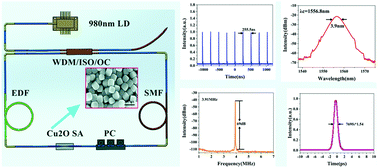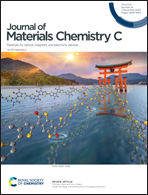Emerging uniform Cu2O nanocubes for 251st harmonic ultrashort pulse generation
Abstract
As a rising star of transition metal oxides (TMOs), cuprous oxide (Cu2O) has a relatively narrow direct bandgap and features strong light–matter interaction, large optical absorption, large minority carrier diffusion lengths and high exciton binding energy, indicating its broad prospects in the field of photonics and optoelectronics. Herein, novel uniform Cu2O nanocubes are successfully prepared by liquid-phase reduction. However, the nonlinear optical (NLO) properties of Cu2O nanocubes and their applications in ultrafast photonics are rarely explored. The modulation depth (12.2%) and saturation intensity (65.8 MW cm−2) of Cu2O nanocubes are demonstrated experimentally, which indicates the excellent potential of Cu2O nanocubes in photonics among the emerging novel NLO materials. Meanwhile, the surface morphology, photoluminescence (PL) characteristics and chemical composition of Cu2O nanocubes have been systematically investigated. More importantly, a high repetition rate (HRR) of a ≈1 GHz ultrashort pulse laser with a 682 fs pulse width is obtained based on the Cu2O nanocubes as a saturable absorber (SA) in the telecommunications band for the first time. Considering the outstanding NLO properties and relatively narrow direct bandgap, these studies pave the way towards advanced photonics based on the Cu2O nanocube material.



 Please wait while we load your content...
Please wait while we load your content...